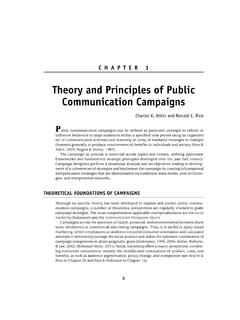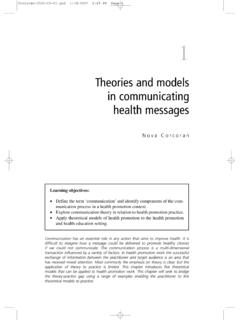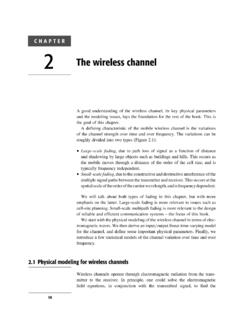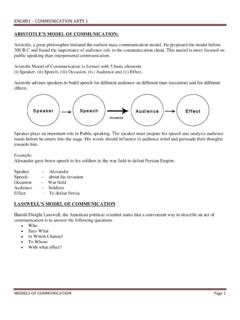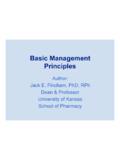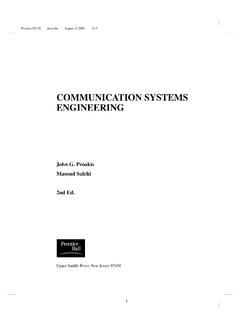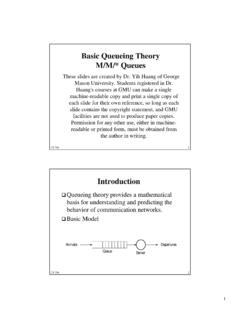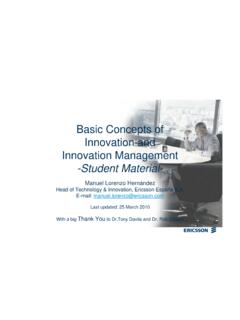Transcription of FIVE PROGRAM MODELS FOR REDUCING RECIDIVISM
1 FIVE PROGRAM MODELS FOR REDUCING RECIDIVISMP ublished byThe Maryland Public Policy InstituteOne Research Court, Suite 450 Rockville, Maryland 2021 Nothing written here is to be construed as the official opinion of the Maryland Public Policy Institute or as an attempt to aid or hinder the passage of any bill before the Maryland General PROGRAM MODELS FOR REDUCING RECIDIVISM BY SEAN KENNEDYAPPROACHING RECIDIVISM AND RE-ENTRYRe-entry success for released prisoners is hard to define as different stakeholders, including former inmates themselves, disagree on what measures return productive and reformed citizens.
2 But the narrower and clearer metric for successful re-entry is RECIDIVISM , or the rate and nature of re-offense by the released inmate. Still, the more limited term is measured differently by experts, institu-tions, and policymakers, creating an often-incomparable data patchwork and, thus, a knowledge gap as to what inputs create what outputs for RECIDIVISM . For example, some jurisdictions and organizations track re-arrest rates, others track re-conviction rates, and still others track re-incarceration and do not necessarily adjust for the underlying offense type, such as parole violation or new crime, or the peculiarities of jurisdiction s rules, varying leniency for cer-tain crimes or violations based on law or offenders history.
3 By defining these terms differently and over different time frames, comparative analysis is nearly impos-sible since data sets do not measure the same thing over the same myriad of variables makes the success of RECIDIVISM reduction programs particularly hard, but not impossible, to assess on a purely quantitative basis. This study seeks to build on existing what works literature to identify effective strategies and PROGRAM components. It then applies qualitative analysis to five RECIDIVISM reduction programs with diverse approaches and circumstances to determine if those strategies are designed, implemented, and assessed to successfully rehabilitate inmates and reduce the perfect formula for successful re-entry remains elusive, extensive research and analysis has identified the primary components of effective RECIDIVISM reduction.
4 2 Five PROGRAM MODELS for REDUCING RecidivismA 2019 study by Harvard s Institute of Politics con-cluded that interventions must address health, employment, housing, skill development, men-torship, and social networks, as these factors have the most significant impact on reentry success. 2 Other analyses add critical factors including finan-cial support, transportation, childcare, and moti-vation. This study categorizes these different com-ponents into three pillars that affect RECIDIVISM reduction: basic needs, opportunity, and social support and accountability.
5 These categories often overlap, interrelate, and vary based on specific in-mate of these needs can be satisfied by attaining the other pillars an employed returned citi-zen can acquire housing and transportation. Often one is prerequisite to meeting related needs an untreated released inmate cannot work or ac-cess other services easily. 1. Basic needs encompasses housing, transpor-tation, health care including substance abuse and mental health care, childcare, and financial Opportunity includes employment and educa-tion which can provide income, stability, ac-countability, and, critically, purpose.
6 3. Support and accountability consists of build-ing and maintaining positive relationships with family, friends, mentors, colleagues as well as authorities parole and probation ser-vices. These networks can provide both basic needs assistance and opportunity and serve as motivation and accountability for the returned citizen to avoid recidivating. Each of these pillars requires the inmates own drive to rehabilitate themselves. They are not pas-sive actors in their own re-entry and no amount of resources or well-designed PROGRAM can replace the releasees willing participation in their own re-habilitation.
7 And that commitment to change and preparation for new and successful life on the out-side begins behind bars. In many ways, re-entry begins on prison intake, not exit. Each of the profiled programs in varying degrees and to varying levels of success seek to reach inside the wire to make prisoners lives more suc-cessful on the outside. The programs examined include: 1. Privately managed PROGRAM in state facilities Continuum of Care 2. State-run PROGRAM /coordinated with outside providers Georgia PRI cohort (2015 to 2019) 3. Nonprofit PROGRAM in privately managed, state-owned facility Prison Entrepreneurship PROGRAM 4.
8 Nonprofit PROGRAM outside prison coordinated within state facilities Vehicles for Change5. University-run college education PROGRAM in state-run facility University of Baltimore s Second Chance ProgramEXECUTIVE SUMMARYB roadly, incarceration in prison serves three key societal functions: to punish offenders and deter others; to incapacitate criminals or protect the public and prevent future crimes; and to rehabili-tate or reform offenders for a safe and productive return to society. Within those functions, there are basic outcomes that can be assessed.
9 While punishment and incapacitation can be achieved through physical means and require de-fined state action sentencing etc. rehabili-tation requires significant effort on the part of the inmate, prison officials and staff, and post-release service providers and other third parties to suc-cessfully re-integrate the offender back into society. The chief metric for rehabilitation is recidi-vism or the rate and nature of re-offense by the released are effective at punishing offenders, but not successfully rehabilitating them.
10 Prison time is of-ten not spent productively. But some innovative programs over the past two decades have sought to change that. This paper profiles five recidi-vism reduction MODELS across the United States based on what other effective programs evince. Programs should deliver the three pillars to inmate 3 Five PROGRAM MODELS for REDUCING Recidivismparticipants: meet basic needs, offer opportunity, and provide support and PROGRAM both succeeds and falls short of de-livering all these equally to their inmate partici-pants, thus have room for improvement.
